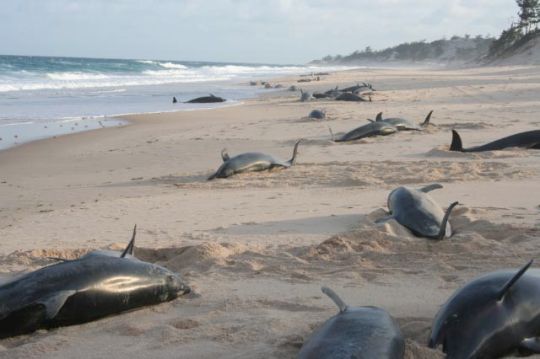The following is a guest post from a friend of mine, Michael Stocker, director of Ocean Conservation Research.
—–
When it comes to national security interests, I can accept a little obfuscation by our military. But with the recent U.S. Navy press activities on the effects of active sonar on marine life, they are puttin’ lipstick on a pig. If their current position is to be believed, only six beaked whales have ever been killed due to active sonar. This was in the 2000 Bahamas stranding and was a consequence of a “rare confluence of conditions that do not apply to sonar testing.”
Last week came this CNN report:
The Navy produces, “for CNN cameras,” a mitigation scenario where whales were accorded a “call to battle stations” response every bit as urgent as would be accorded a silent submarine. The report also played a simulated sonar “ping,” giving the viewers a chance to hear for themselves what the fuss is about.
This old style “ranging” sonar ping was the cherry on top of a puff piece that had very little to do with the modern ear-ripping, mid-frequency digital communication signals that are throwing marine mammals into a panic, and which occasionally lead to strandings.
Other common propaganda tools are evident in the many print pieces popping up in the news, where facts are not refuted — they just “don’t exist in the record,” and the irrefutable facts are buried in noise.
An article in the November issue of Marine Technology Reporter enumerated a laundry list of potential causes for whale strandings, which included “disease, parasite infestation, algal blooms, magnetic anomalies, geophysical or geochemical events, meteorological events such as solar flares [sic], injuries from ship strikes or fish net entanglements, changing oceanographic conditions, presence of predators or prey in abnormal near shore areas … general disorientation, starvation, bad timing …” and the list goes on, finally stating that active sonars “have been correlated to only a very small fraction of strandings worldwide.”
If someone can show me one scientific paper correlating whale strandings with solar flares, I will personally request that all of my tax dollars go directly toward performance bonuses for R. Adm. Larry Rice, CNO Environmental Readiness Division — a source of many of these statements.

Mass stranding of Dolphins in Mozambique in 2006. Naval operations within 300km and 24 hours of the incident, though no necropsies were performed to confirm the cause. Photo credit: Nick Raba, Eyes on the Horizon
So what happened to the two minke whales and the nine other beaked whales that died on the Bahaman sands in 2000? (Or the other 20 in that pod that have not been seen since?) What about the 10 beaked whales in Gran Canaria in 2002, the 200 panicked melon headed whales in Hanalei Bay in 2004, the panicked orcas in Haro Strait in 2003, the 37 mixed-species strandings in Outer Banks N.C. in 2005, the 62 rough-tooth dolphins in the Florida Keys in 2005, the 540-plus dolphins on the Mozambique coast in 2006, or … this list goes on.
All of these events have been correlated to Navy sonar activities. But unlike the six beaked whales from the Bahamas stranding, there were no necropsies on these other victims. No necropsy, no correlation. Science rarely gets this simple!
So the next time we have some unusual solar flare activity, perhaps we’ll find Adm. Rice and his staff on the beach waiting to collect on my income tax offer.
Hear more ocean sounds, human and otherwise, on OCR’s ocean sounds pages.

